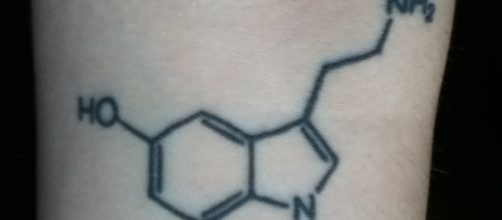Chemical formula: C10H12N2O
(10 Carbon atoms, 12 Hydrogen atoms, 2 Nitrogen atoms, 1 Oxygen atom)
There are a lot of general misconceptions about serotonin. This is largely because there are multiple areas of study involving it. The largest misconception is that is has a fairly specific purpose. Serotonin can often times be referred to as "the happy chemical," because it has been studied in relation to mood and mental disorders.
Interestingly, serotonin is present in far more areas of the body than just the brain. Serotonin is found in the brain, bowels, and blood platelets.
In fact, it is primarily in the gastrointestinal (GI) tract and is mostly used to regulate intestinal movement.
Regulation
Serotonin, in general, is just a regulatory substance. The list of functions it regulates includes:
- Mood
- Appetite
- Sleep
- Intestinal Movement
- Clotting
- Memory
- Learning
- Aging
The direct, dictionary definition of serotonin is as follows:
"A compound present in blood platelets and serum that constricts the blood vessels and acts as a neurotransmitter."
Serotonin is found not only in humans, but other mammals, worms, insects, and fungi. In plants, serotonin is referred to as phytoserotonin -- or plant serotonin. The presence of serotonin in Plants And Animals manifests in their interactions and survival instincts.
The serotonin in both venom and spines in plants and animals causes pain. It also mediates the perception of resources, and stress signals.
This perception of resources and regulation of stress may also be why it is associated with mood. When one perceives that their resources are depleted, their stress levels do go up, and they generally feel less happy. When one perceives a good amount of resources, and has lower stress levels, feeling better is a general outcome.
Serotonin, akin to other chemicals of its kind, can be dangerous in certain amounts. It can be dangerous when there is too much and manifest as Serotonin Syndrome, and it can be dangerous when there is too little.
In practice, serotonin can be used in a wide variety of ways.
Its stimulation and blocking are directly related to different effects in both the body and the brain.
- Anti-depressants (fighting depression)
- Anti-emetics (fighting nausea)
- Anti-migraine (fighting headaches)
- Premenstrual Syndrome (fighting cramping)
Drugs
Certain psychedelics are known to enhance the production of serotonin, while others are thought to block it. This is not always a problem unless they are crossed with another chemical that either also enhances or prevents the recycling of the compound itself. Which means it sits and waits until it absorbs into your system instead of some getting absorbed and the rest getting moved around to different parts of the body.
This can also be the effect of certain prescribed medications -- which is why it is dangerous to combine substances of any sort.
It can be very dangerous if someone mixes drugs that enhance serotonin while also taking a serotonin blocker (often called SSRI's/SRI's or Selective/Serotonin Re-uptake Inhibitors).
This dangerous combination can heighten the amount of serotonin present in the body -- with the enhancer, and instead of taking it to regulate other bodily processes, the body blocks it -- with the SSRI/SRI. This means that it doesn't keep flowing through the system and regulating bodily functions, it pauses, and in order to remove the build-up, the body and brain have to absorb it all. This means that an excess amount of serotonin can be absorbed into the brain -- which can often lead to psychosis, suicidal thoughts, and depression.


